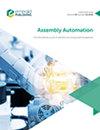Research on optimization of assembly line based on product scheduling and just-in-time feeding of parts
IF 1.7
4区 计算机科学
Q3 AUTOMATION & CONTROL SYSTEMS
引用次数: 2
Abstract
Purpose Reducing production auxiliary time is the key to improve the efficiency of the existing mixed-flow assembly line. This paper proposes a method combining improved genetic algorithm (GA) and Flexsim software. It also investigates mixed-flow assembly line scheduling and just-in-time (JIT) parts feeding scheme to reduce waste in production while taking the existing hill-drop mixed-flow assembly line as an example to verify the effectiveness of the method. Design/methodology/approach In this research, a method is presented to optimize the efficiency of the present assembly line. The multi-objective mathematical model is established based on the objective function of the minimum production cycle and part consumption balance, and the solution model is developed using multi-objective GA to obtain the mixed flow scheduling scheme of the hill-drop planter. Furthermore, modeling and simulation with Flexsim software are investigated along with the contents of line inventory, parts transportation means, daily feeding times and time points. Findings Theoretical analysis and simulation experiments are carried out in this paper while taking an example of a hill-drop planter mixed-flow assembly line. The results indicate that the method can effectively reduce the idle and overload of the assembly line, use the transportation resources rationally and decrease the accumulation of the line inventory. Originality/value The method of combining improved GA and Flexsim software was used here for the first time intuitively and efficiently to study the balance of existing production lines and JIT feeding of parts. Investigating the production scheduling scheme provides a reference for the enterprise production line accompanied by the quantity allocation of transportation tools, the inventory consumption of the spare parts along the line and the utilization rate of each station to reduce the auxiliary time and apply practically.基于产品调度和零件实时进给的装配线优化研究
目的减少生产辅助时间是提高现有混流装配线效率的关键。本文提出了一种将改进遗传算法(GA)与Flexsim软件相结合的方法。研究了混合流装配线的调度和JIT (just-in-time)送料方案,以减少生产中的浪费,并以现有的坡降混合流装配线为例验证了该方法的有效性。设计方法本文提出了一种优化现有装配线效率的方法。以最小生产周期和零件消耗平衡为目标函数,建立了多目标数学模型,并利用多目标遗传算法建立了求解模型,得到了坡地播种机混合流调度方案。在此基础上,利用Flexsim软件对生产线库存、零件运输方式、每日进料时间和时间点等内容进行建模和仿真研究。研究结果:本文以斜插式播种机混流装配线为例进行了理论分析和仿真实验。结果表明,该方法可以有效地减少装配线的闲置和过载,合理利用运输资源,减少生产线库存的积累。本文首次采用改进的遗传算法与Flexsim软件相结合的方法,直观高效地研究了现有生产线的平衡和零件的JIT送料。研究生产调度方案,为企业生产线配套运输工具的数量分配、沿线备品备件的库存消耗和各工位的利用率提供参考,以减少辅助时间并实际应用。
本文章由计算机程序翻译,如有差异,请以英文原文为准。
求助全文
约1分钟内获得全文
求助全文
来源期刊

Assembly Automation
工程技术-工程:制造
CiteScore
4.30
自引率
14.30%
发文量
51
审稿时长
3.3 months
期刊介绍:
Assembly Automation publishes peer reviewed research articles, technology reviews and specially commissioned case studies. Each issue includes high quality content covering all aspects of assembly technology and automation, and reflecting the most interesting and strategically important research and development activities from around the world. Because of this, readers can stay at the very forefront of industry developments.
All research articles undergo rigorous double-blind peer review, and the journal’s policy of not publishing work that has only been tested in simulation means that only the very best and most practical research articles are included. This ensures that the material that is published has real relevance and value for commercial manufacturing and research organizations.
 求助内容:
求助内容: 应助结果提醒方式:
应助结果提醒方式:


